Reviews
Erich von Stroheim
USA, 1924
Credits
Review by Ian Johnston
Posted on 29 August 2009
Source TCM Broadcast
Categories Oh, the Depravity! The Cinema of Erich von Stroheim
I never truckled; I never took off the hat to Fashion and held it out for pennies. By God, I told them the truth. They liked it or they didn’t like it. What had that to do with me? I told them the truth. I knew it for the truth then and I know it for the truth now.
Coming at the very start of Greed, this appears as nothing short of von Stroheim’s artistic manifesto, a dedication to the seeking out of “the truth” at whatever the cost. And we’re aware of what the cost entailed, given that today more people are probably familiar with the myth of von Stroheim’s fall from grace than with the films themselves. That fall brought him from the heights of a commercial if provocative success (Blind Husbands, the now lost Devil’s Passkey, Foolish Wives), through firings (Merry-Go-Round, Queen Kelly, Walking Down Broadway) and studio interference/re-editing (almost all of his films, and most notoriously Greed), to a directorial silence that lasted from 1933 to his death in 1957.
But in fact this quote is from Frank Norris, author of McTeague, the novel on which Greed was based, and it’s a sign of both how von Stroheim proposes his film as a faithful adaptation of the novel and how he invokes Norris as justification for his choice of style and theme. Greed’s very first shot is of Norris’ book, which then opens to display the film’s epigraph; and all through the film intertitles will be signed “F.N.”, marking them as direct transpositions of lines from the novel.
Von Stroheim, whose own realist style to date had been characterised by an almost obsessive accumulation of detail (in itself the source of the depth and richness of the world of the von Stroheim film), is committing himself to Norris’ literary Naturalism, with its pessimism, determinism, and self-claimed “scientific” analysis of the workings on character of environment and heredity. It’s this latter aspect which today always seems the most over-determined aspect of Naturalism. In Jean Renoir’s adaptation of Zola’s La bête humaine the hereditary bad blood poisoning Jacques Lantier, ready to turn him into an uncontrollable killer, seems an excessive, unnecessary addition to Lantier’s personality; and in terms of the plot it is a curious muddying of the waters and hardly to the point — the focus should be on Lantier’s sexual obsession with Séverine.
Von Stroheim certainly subscribes to the hereditary reading. An early intertitle comments that “below the fine fabric of all that was good in [McTeague] ran the foul stream of hereditary evil, like a sewer,” and he even invents a substantial prologue not found in the novel which, among other things, highlights McTeague’s foul, violent, drunken father as what will be later seen as the source of McTeague’s own character. Yet, at the same time, this never really appears central in any convincing sense to an interpretation of what happens to McTeague. More at issue in determining McTeague’s decline is the combination of chance, social/economic factors, and the baser human emotions (Marcus’ malice and envy, Trina’s miserliness, greed, and deception).
Von Stroheim was often described as taking a very literalist approach to his adaptation of Greed, filming page by page, if not paragraph by paragraph, and producing this enormous amount of material that landed on the editing desk. So, it’s important to point to the lengthy prologue as the most obvious sign of the additions and alterations he made to Norris’ novel, remaining true to the work and yet at the same time making it his own. Still, the length of the project — the eventual shooting schedule, the 446,103 feet of negative he ended up shooting — raises a central question: given the studio conflicts he had already experienced, how on earth did von Stroheim think he was going to get away with it?
Greed was to be the first in a three-film contract von Stroheim signed with the Goldwyn Company on November 20, 1922. (Only weeks before, on October 6, Irving Thalberg had fired him from Universal.) The Goldwyn contract itself was fairly restrictive, full of stipulations on film length, budgets, and scheduling, and of financial penalties if von Stroheim failed to meet any of those demands. Perhaps he felt that the gods would be with him, once the studio started adjusting the budget and film up on receipt of his completed script. Or maybe it was the literal distance from the studio, with the three shooting locations of San Francisco, Death Valley, and the Big Dipper Mine; surrounded by his chosen cast and crew, he could focus on the process of filmmaking. Certainly, the length of time it took him to attempt to edit the footage to a length acceptable to the studio (in the event, he couldn’t do it) makes you wonder if he ever conceptualised the final form of his film while he was shooting it. One thing can be certain: he never expected the irony, greater than any that occurs in Greed itself, of Goldwyn merging with Metro to form M-G-M and of Irving Thalberg returning as the new head of production.
Out of all the competing edited versions of Greed that were done in 1923-24, only the studio-approved ten-reeler was ever released to the public. Before that there were von Stroheim’s own mythical 42 reels (or 40, or 45, or 47…about 8-9 hours); simultaneously, a thirteen-reel Goldwyn version, then reduced to twelve; another von Stroheim version of 22 to 28 reels; and a two-part fifteen-reeler that von Stroheim’s friend Rex Ingram arranged for editor Grant Whytock to do. So, a “complete” Greed, true to von Stroheim, has only existed in the imagination — it’s this ideal Greed that has appeared in critics’ top ten lists since the 1950s, a film it would seem none of those critics has ever seen. The four-hour version that Rick Schmidlin produced for TCM in 1999, where the ten-reeler is bulked out with still shots to approximate Stroheim’s “continuity screenplay,” is the closest we can get, but it’s still one where we imagine von Stroheim’s masterpiece.
In Schmidlin’s reconstruction, as minutes of still photos follow one another, we get a real sense of what was lost in the ten-reel version. The essential story remains the same: McTeague, a young worker at the Big Dipper Mine, becomes an assistant to an itinerant quack dentist and then sets himself up in a poor area of San Francisco running an unlicensed dental practice. There, he makes friends with Marcus Schouler and falls for Marcus’ cousin and girlfriend Trina Sieppe. Made aware of this, Marcus relinquishes his claim on Trina, and then immediately regrets it when Trina wins $5,000 in a lottery. Marcus’ regret turns to resentment, envy, and straight-out malice, one result being that he secretly engineers McTeague’s loss of profession. Trina’s increasing miserliness and psychotic obsession with money both accompany and contribute to the McTeagues’ economic, physical and moral decline, and the story ends with a series of killings and the deaths of all the main characters.
The TCM version clearly shows how much our ideal Greed gains in depth and complexity over the 1924 ten-reel release. Von Stroheim was a great believer in carefully planting hints that can alert the audience to future developments of plot and character, and for this he needed time, the length of a longer version. He does this through plot incidents, such the early scene of McTeague’s rescue of a bird and then attack on a fellow miner who knocks it out of his hand, thus establishing both the essential good-heartedness of this big man and the propensity for violence that lies underneath.
He also does this through extended series of motifs that run throughout the film. One gruesome aspect to Trina’s end, her gangrenous fingers that have to be amputated, are prepared through variations on the motif of Trina’s fingers: the fingers she catches in her mother’s mouthtrap after McTeague first kisses and “wins” her; the fingers she holds to her lips in apprehension on her wedding night; the finger she sucks when she wonders where McTeague gets money for whiskey; and her fingers that McTeague literally gnaws on to force some money out of her. This slow build-up is also a feature of Trina’s characterisation in general. In the short version she dramatically turns into a miser; in the long version, the change is more subtle: early signs of thriftiness, Freudian slips (the lottery money is “mine” — “I mean it’s ours”), and a pettiness about paying her way that she can immediately regret slowly develop into a full-blown obsession with her hoard of coins, in parallel to the decline into squalor and degradation that her life with McTeague undergoes.
Von Stroheim also provides parallels between the McTeagues and two other sets of couples, underlining the separate light and dark potentialities that life has to offer. On the one side, there’s the sweet romance between the elderly couple, Old Grannis and Miss Baker; on the other, the dark mirror-image of the McTeagues’ own relationship that is offered by the marriage between Zerkow the junkman and Maria Macapa the cleaning woman — their relationship, like the McTeagues’, ends in greed, an all-consuming obsession with a secret hoard, murder, and the death of the murderer. (Both parallel narratives were cut from the original release.)
This use of motifs and parallels points to how there is more to von Stroheim’s “realism” than simply the inscription of the physical world he sets up before the camera. True, there’s a fascination to be had with the depth of detail von Stroheim fills his images with and the depth of field (playing off foreground and background) he will sometimes work with. The famous sequence of McTeague and Marcus sitting in front of large windows as holidaymakers parade along the boardwalk behind them still works today as a stunning piece of filmmaking. Shooting on location allows for a heightened sense of authenticity; von Stroheim was doubtless right that no alternative location could reproduce the sense of desolation and despair that he obtained from his suffering actors and from the locale itself in Death Valley. It also allows for marvelous, unscripted serendipities, such as the breeze-blown tassel that swings against the head of the minister as he officiates at Trina and McTeague’s wedding.
But von Stroheim’s realism entails much more than the dour record of social decline you might expect from a bald plot summary of Greed. There’s a constant mixing of tones, with Stroheim frequently switching between comedy, irony, and satire (e.g. the Sieppe family’s July 4th outing) and indulging in his taste for the grotesque. Then there’s the issue of von Stroheim’s overt use of symbolism. Both contemporary reviewers and later critics have been uncomfortable with the gold colour-tinting that’s used selectively to highlight motifs (gold, coins, teeth, canaries) which then acquire symbolic significance (greed, ambition, kind-heartedness, and so forth). But really this symbolism is central to the artistic project at work in Greed and a sign of how much aesthetically von Stroheim is of the nineteenth- rather than the twentieth-century. There’s no reason to think that the Victorian-flavoured moralistic endings that he gave Blind Husbands and Foolish Wives were not intended by von Stroheim right from the start rather than studio- or censor-imposed. Indeed, the Charles Dickens of Our Mutual Friend, with its moralism, symbolic dust-heaps and grotesques like Silas Wegg, seems a truer model for von Stroheim’s brand of realism than the naturalism of Zola and Norris.
The symbolism at work in Greed finds its apotheosis in the final sequence in Death Valley. The social world that has been given to us in such fine detail is now left far behind. On the empty stage that is the desert floor there now plays out the final struggle between Marcus and McTeague, all reduced to the bare essentials. It’s also where Greed in spirit leaves the nineteenth-century and projects itself into the despairing modernity of the twentieth. You have to go into the seventies to find an equally bleak ending to an American studio film (Night Moves, perhaps). With the blood-spattered gold coins scattered around him, chained to a dead man, and inevitably to die himself, McTeague’s one act to reassert his essential humanity — the release of his caged canary — turns to nought. The film’s final long shot, where McTeague and Marcus are almost lost in the heat haze, only serves to underline (notwithstanding the attempt at a comforting moralism in the final title-card) the hopeless, empty meaninglessness of that gesture.
More Oh, the Depravity! The Cinema of Erich von Stroheim
-

Blind Husbands
1919 -
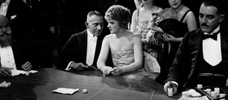
Foolish Wives
1922 -
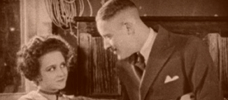
Merry-Go-Round
1923 -
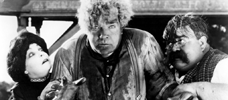
Greed
1924 -
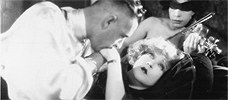
The Merry Widow
1925 -
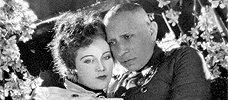
The Wedding March
1928 -

Queen Kelly
1929 -
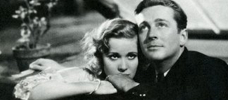
Hello, Sister!
1933
We don’t do comments anymore, but you may contact us here or find us on Twitter or Facebook.



